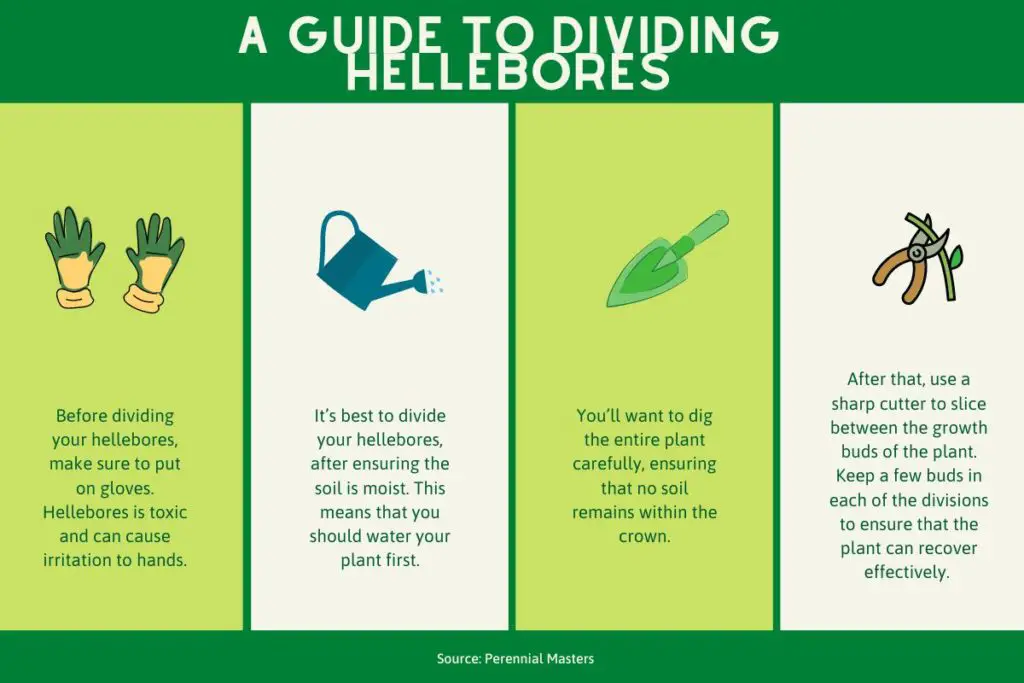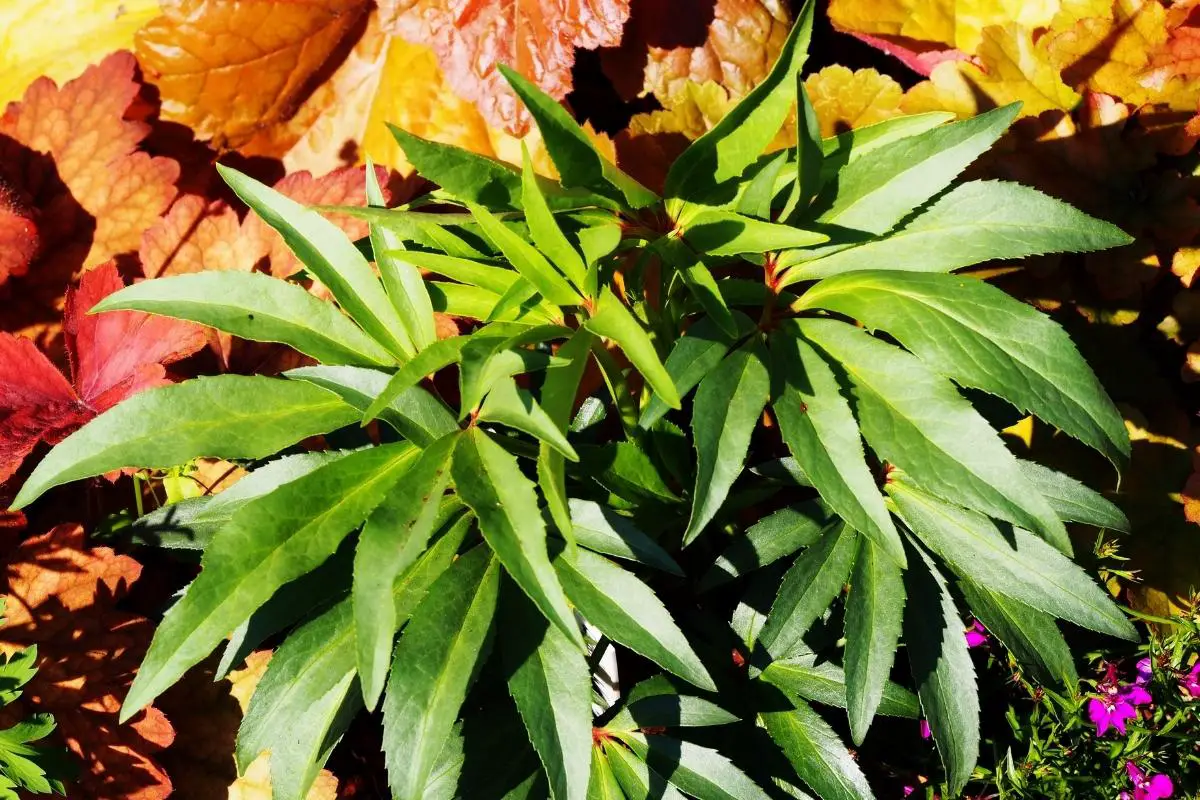Dividing hellebore plants can be an important activity to keep your delicate plants healthy and thriving. Several reasons dividing Hellebores can be beneficial, but it can also help expand the region of your garden. Hellebores is a perennial plant that puts out beautiful flowers. There are many different varieties, such as the Christmas rose, and the Lenten rose, both of which are evergreen perennials.
Many gardeners elect to divide their Hellebores to ensure their plant’s health and to improve their growth potential. While dividing Hellebores is relatively straightforward, there are some important things to keep in mind when doing this.
When dividing a Hellebore, you’ll want to equip yourself with safety gloves so that you don’t expose yourself to harsh skin irritation from coming in contact with this plant. You should divide a Hellebore as early in the morning as possible and ensure that you carefully transplant it into a new location with partial sunlight and partial shade.
We’re going to talk a little bit about the best time of the year to divide your Hellebore plants. There are a couple of times that make the most sense. Those ideal times are usually during autumn or winter.
See our article for Christmas Rose here.
Table of Contents
When Should I Divide Hellebores?
Since hellebores are ideally divided right before they bloom, autumn and winter are excellent seasons to divide your hellebores. It’s not always ideal to divide your hellebores. The plant can generally survive easily on its own without dividing it.
If you do wish to divide and transplant hellebore, you should try to do it between September and December. If you choose to divide your hellebores during another time of year, then you may risk complications and other unexpected outcomes.

How to Divide Your Hellebores?
Dividing Hellebore is very easy, as long as you keep a few things in mind. If you are dividing and moving parts of the plant, you need to make sure that you are moving it into an area with ideal conditions. Dividing Hellebore is an easy, three-step process.
Step 1
It’s best to divide your hellebores, after ensuring the soil is moist. This means that you should try to water your plant before starting the division process. Dig the exterior soil around the plant and carefully lift the surrounding area of soil to gently remove the plant from the ground.
Step 2
You’ll want to dig the entire plant carefully, ensuring that no soil remains within the crown. This will make the process much easier and allow you to have a complete understanding of what you are looking at.
Step 3
After that, use a sharp cutter to slice between the growth buds of the plant. Keep a few buds in each of the divisions to ensure that the plant can recover effectively.
Dividing your plants doesn’t only expand a clone of your original single plant, it also keeps all of the initial traits. It’s always important to wear safety gloves that are completely protective of your hands and fingers due to the potential for skin irritation from touching a hellebore plant.
How To Transplant Your Hellebores?
For the best overall experience, always try to find appropriate regions for transplanting. You should also always try to divide your plants at the appropriate time of the year to ensure the best outcome. Moving hellebores after they are a couple of years old makes it harder to have success. Luckily there are other methods of moving plants, such as using seedlings.
Transplanting Hellebores
Besides dividing hellebores, there are other reasons for transplanting. One reason is that they are too low in the ground. Another reason is that you may want to enrich your already existing soil with compost.
Also, the amount of sunlight reaching your hellebores may be too much or too little. If you’ve had another plant in your garden that wasn’t getting enough sun, moving them to a spot in your garden that better suits them and putting hellebores in their place is a wonderful idea.
Fertilizing hellebores in your garden is not necessary because the compost should provide the needed nutrition. That being said, a slow-release, eight- to nine-month fertilizer can be beneficial in the spring. In the fall, extra nitrogen and iron will help them initiate flowering. Hellebores love loamy soil. Whether you are transplanting, dividing, or planting new, do not underestimate this type of soil because it is imperative for the overall health of your plant.
When To Transplant Hellebores
Hellebores should be transplanted during their dormant period in the fall. You can move hellebores anytime, but doing so in the early fall helps them recover quickly and allow for flowering the next spring. While this is hopeful, of course, this is not always the case and it may take a couple of years for the hellebores to fully recover and begin to flower again.
Preparing The New Location For Your Hellebore Transplants
Once again, whether transplanting, dividing, or planting new hellebores, they should always be planted in regions that support their growth. This generally includes regions that experience partial shade and partial sun. Well-draining soil is also a crucial factor in the new location where you transplant your hellebores. Ideally, you want to add two to three inches of compost that you will work into the soil as far down, or a little further, than the root system of your transplants.
Before you put your hellebores back in the ground, make sure that you have prepared the new location properly. It helps to fill the hole that you have dug in preparation for the transplants with water and let it drain. Mixing compost in with the existing soil encourages root growth, not only in the nutrient-rich compost but also in the soil around it.
Moving Your New Hellebore Transplants To Their New Location
When digging your hellebores for transplant, you want to make sure you get enough of the root system for them to re-establish themselves. Always start at the outer leaf tips. This is called the drip line. Then, dig six to eight inches down. You want to make sure that the point where the root meets the stem is at the same level, or slightly above, the top of your soil. Placing your hellebores too low can cause rot. Especially, if there is any standing water where the stem meets the roots.
Often, when dividing hellebores, the individual clumps will simply pull apart without the need for a knife or a spade to cut them. Others may not, though, so you will need to keep a tool on hand to assist you with this task. Keep them in water until you’re ready to put them in their new location. Let the plant settle and stabilize into the soil and ensure that the soil surrounds the exterior of the crown. Keep the fresh soil properly watered so that it remains moist.
Transplanting Seedlings
Another way to propagate your hellebore is a seedling transplant. As the plant flowers, it produces seeds that will appear at the base of the mother plant. The best time to transplant seedlings is in the spring. You will want to transplant before new foliage from the parent plant blocks the sun, but make sure that they have their first set of true leaves before trying to move them.
With both seedlings and divisions, you will want to get the plants back into the soil quickly. When moving seedlings into pots, you will want to use containers that are at least 8 inches in diameter. Also, make sure that your new containers have weep holes that will allow for proper drainage. When transplanting seedlings don’t be surprised if the flower doesn’t turn out the same color as the mother plant .Source.
Do You Have to Divide Hellebores?
It’s certainly not a mandatory thing to do if you have a hellebore plant in your garden. Hellebores can divide and spread on their own without any assistance, but it can be a healthy thing to do, especially when done correctly.
If you take all of the necessary precautions and complete a reasonable amount of planning before you divide and transplant your hellebores, you’ll be grateful to learn that it can benefit the health of your plant. It will also allow you to clone and recreate additional, identical variations of the same parent plant in new areas.
Related Questions
Why is it bad to divide hellebores in the summertime or springtime?
You shouldn’t divide your hellebores until right before they bloom for the best outcome. For these reasons, it’s not ideal to divide them in the summertime or the springtime. In addition, you should try to only divide them between September and December.
Is dividing hellebores really necessary?
While it’s definitely not a requirement, there are certainly some positives to taking action. Dividing or transplanting a hellebore plant can be beneficial in the longer term. The process of dividing a hellebore plant temporarily weakens the structure of the divided plant with the hopes of expanding and recovering.

